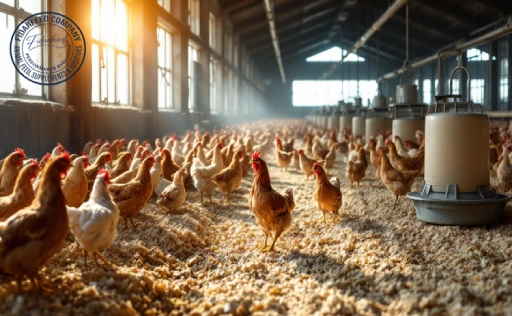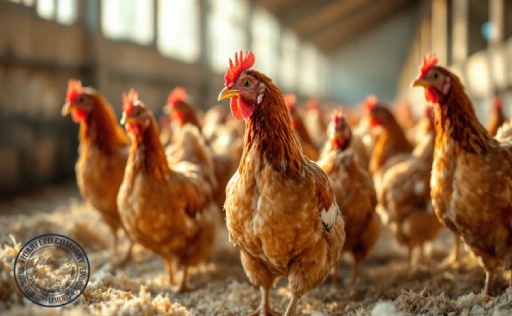
Meat Meal vs. Soybean Meal is one of the most important comparisons broiler breeders must consider when optimizing nutrition for chick growth. With the rise in feed costs and the constant push for better performance, choosing the right protein source can make a big difference. In this article, we’ll explore the pros and cons of each, backed by science and real-world farm results, to help you unlock superior nutritional benefits for your broiler chicks.
Introduction: Why Feed Choice Matters for Broiler Chick Growth
Meat meal vs. soybean meal is a hot topic in the broiler breeding world—and for good reason. The feed you choose for your broiler chicks can mean the difference between average performance and exceptional growth. Whether you’re managing a large commercial farm or a small-scale operation, the right protein source lays the groundwork for healthy, fast-growing birds.
Learn more about: Processed Meat Meal
This article explores the nutritional, practical, and economic sides of meat meal and soybean meal, helping you make informed decisions that directly impact flock performance. Let’s dive in and discover which feed delivers the superior nutritional benefits for broiler chicks.

Nutritional Breakdown: Meat Meal vs. Soybean Meal Compared
To compare meat meal vs. soybean meal fairly, let’s begin with the numbers. Meat meal typically contains 55% to 65% crude protein, along with high levels of essential amino acids like lysine and methionine. It’s also rich in minerals such as calcium and phosphorus, which are vital for skeletal development.
Learn more about: Meat and Bone Meal for Poultry: Affordable Alternative to Soybean Meal
Soybean meal, on the other hand, is plant-based and boasts about 44% to 48% protein. While it’s an excellent source of lysine, it tends to be lower in methionine. It also contains anti-nutritional factors such as trypsin inhibitors and oligosaccharides, which can interfere with protein digestion unless properly heat-treated.
Superior Nutritional Benefits for Broiler Chicks: What Science Tells Us
Scientific studies consistently show that broiler chicks fed diets including meat meal often exhibit superior feed conversion ratios (FCR), higher daily weight gains, and improved carcass yields. For instance, a study published in the Journal of Applied Poultry Research demonstrated that chicks receiving a balanced amount of meat meal in their starter diet reached market weight faster than those on a soybean-only diet.
Learn more about: Meat Meal in Animal Feed: What It Is, How It’s Made, and Why It Matters
Soybean m
eal is no slouch either. It provides a consistent, high-quality plant protein source, especially when supplemented with synthetic methionine. But when compared head-to-head, meat meal often gives
chicks a more robust start due to its highly digestible anim
al proteins and mineral content.

Digestibility and Gut Health: Which Feed Supports Better Absorption?
Protein is only useful if it can be absorbed. In this area, meat meal has a clear edge. Animal-derived proteins generally have higher digestibility rates in poultry due to their amino acid profiles being closer to what birds naturally require.
Soybean meal can sometimes cause digestive issues in young chicks if not properly processed. Undigested oligosaccharides in soybean meal can ferment in the gut, leading to gas buildup, diarrhea, or reduced nutrient absorption. However, the inclusion of enzymes like protease or prebiotics can mitigate these effects, leveling the playing field somewhat.
Cost vs. Value: Evaluating Economic Efficiency in Feed Selection
The price tag on meat meal is usually higher than soybean meal, mainly due to its animal origin and processing costs. However, the value it brings in terms of faster weight gain, better FCR, and fewer health issues may outweigh the initial expense.
Learn more about: Boost Your Poultry’s Growth with Sustainable, High-Quality Processed Meat Meal
Soybean meal offers predictability in pricing and supply, which makes it attractive for long-term planning. Yet, you may need to invest in additional supplements to match the performance levels that meat meal can provide naturally. Therefore, a holistic cost analysis should include not just price per kilogram, but also the feed’s impact on productivity and bird health.

Sustainability and Sourcing: Ethical Considerations in Feed Choices
As sustainability becomes more critical in animal agriculture, sourcing feed ingredients responsibly matters more than ever. Meat meal is often a by-product of the meat processing industry, contributing to a circular economy by reducing waste. However, its environmental footprint can be high if the source animals were raised unsustainably.
Learn more about: biotechnology in animal feeds and animal feeding
Soybean meal comes with its own ethical challenges, including deforestation, high water usage, and dependency on genetically modified crops. That said, certified sustainable soybean sources and local production initiatives can reduce its impact significantly.
Ultimately, both options can be made more sustainable through careful supplier selection and supply chain transparency.
Formulating the Right Mix: Can Meat Meal and Soybean Meal Work Together?
Absolutely. Many commercial feed formulations successfully use both meat meal and soybean meal to achieve a balanced amino acid profile. Combining them allows nutritionists to take advantage of the strengths of each: the high protein content and digestibility of meat meal, and the affordability and lysine-rich profile of soybean meal.
Learn more about: Mastering the Basics: A Comprehensive Broiler Breeder Management Guide
Such blends can reduce the need for expensive synthetic supplements, improving cost-efficiency while optimizing chick performance. The key lies in adjusting the ratios to suit flock age, health status, and production goals.

Age-Specific Feeding: Matching the Right Feed to Chick Development Stages
Broiler chicks have different nutritional needs as they grow. During the starter phase (0–21 days), chicks benefit greatly from high-protein, easily digestible feeds like those including meat meal. This sets a strong foundation for rapid growth.
In the grower and finisher phases, soybean meal can take on a more prominent role, especially when paired with amino acid supplements or meat meal in smaller quantities. Fine-tuning your feed plan to match development stages helps maximize nutrient efficiency at every step.
Real Farm Results: Breeder Insights on Meat Meal vs. Soybean Meal
Breeders often share mixed but valuable feedback. For example, one mid-scale breeder in Brazil reported a 7% improvement in FCR and 10% faster growth when using a 60:40 mix of soybean to meat meal. In contrast, a breeder in India found that a high soybean meal diet supplemented with enzymes delivered similar results at a slightly lower cost.
Learn more about: The Ultimate Guide to Broiler House Ventilation
These real-world cases show there’s no one-size-fits-all answer. Climate, feed availability, chick genetics, and farm management practices all play a role.

Final Thoughts: Choosing the Best Protein Source for Superior Broiler Chick Performance
In the meat meal vs. soybean meal debate, there is no absolute winner—only the best choice for your unique operation. Meat meal may offer faster growth and stronger performance, especially in the early stages. Soybean meal brings economic and sourcing stability, with the potential for great results when properly formulated.
The superior nutritional benefits for broiler chicks come not just from individual ingredients but from smart, evidence-based feeding strategies. Stay informed, experiment responsibly, and always monitor flock performance. We’d love to hear your thoughts and experiences. Feel free to leave a comment, ask a question, or share your insights below!



